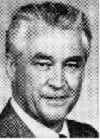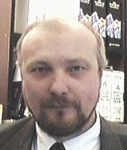-
An Overview of DSL Architecture and Technology, Gottfried W. R. Luderer, Arizona State University, USA
-
Systems Approach to Network Planning and a Role of Requirement Analysis, Algirdas Pakstas, University of North London, UK
-
EMC Computational Techniques Based on Wire Antenna Theory, Dragan Poljak, University of Split, Croatia
An Overview of DSL Architecture and Technology
Gottfried W. R. Luderer, Arizona State University, USA
Abstract: The Digital Subscriber Line technology enables digital broadband access over the wireline telephone network, the most ubiquitously available access to residences and businesses. This seminar will present the DSL architecture with its components within the framework of existing wireline networks. Basic technology includes modulation and interface standards for variants like ADSL and HDSL. Also discussed are current services such as voice over DSL as well as emerging services offered via DSL such as T1/E1, Frame Relay, IP, ATM and Private/Campus LANs. Finally, a network perspective addresses network management aspects like provisioning and access multiplexing.
 Biography:
Dr. Gottfried W. R. Luderer was appointed Professor, ISS Chair of
Telecommunication, at Arizona State University in the Fall of 1990. His
current research program in networking includes work in the areas of control
of ISDN/Broadband ISDN networks, mobile communication networks, and multimedia
communication, which ranges from call processing for intelligent network
services to network management.
Biography:
Dr. Gottfried W. R. Luderer was appointed Professor, ISS Chair of
Telecommunication, at Arizona State University in the Fall of 1990. His
current research program in networking includes work in the areas of control
of ISDN/Broadband ISDN networks, mobile communication networks, and multimedia
communication, which ranges from call processing for intelligent network
services to network management.
Research emphasis is on advanced software technologies for development of
telecommunication networks, as used in switches, for signaling and in network
management, with a focus on object and component technology and formal
definition techniques. Besides the academic involvement at the university, Dr.
Luderer has been teaching short courses since 1992 on high-speed networks and
telecommunication software architecture in various countries. From 1965 to
1989, Dr. Luderer was with AT&T Bell Labs, at last directing research on
next generation switch architectures, based on fast packet switching
technology on the hardware side and object-oriented design technology on the
software side, resulting in some of the earliest demonstration networks for
multimedia communication. Dr. Luderer holds Diplomingenieur (M.S) and Dr.-Ing.
(Ph.D) degrees in Electrical Engineering from the Technical University of
Braunschweig, Germany. He holds two patents. While at Bell Labs, he taught at
Stevens Institute of Technology in Hoboken, NJ, and at Princeton University.
He is member of ACM, IEEE, IEEE Computer and Communication Societies.
Systems Approach to Network Planning and a Role of Requirement Analysis
Algirdas Pakstas, University of North London, UK
Abstract: Tutorial looks at the problem of network planning when network is
considered not as collection of separate components but as a system.
Tutorial consists of two parts. The first part of the Tutorial is devoted to the general overview of
the network analysis and design processes. Network services and services-based networking are discussed. Systems and network services
are presented with more details. Especial attention is devoted to characterizing of services including discussion on service requests,
service offerings, service performance requirements, service metrics, as well as reservations and deadline scheduling.
The second part of the Tutorial is focusing on the concepts of requirement analysis. Description of the background for requirement
analysis is followed by the discussions on User Requirements, Application Requirements (types of applications, reliability, capacity,
delay, application groups), Host Requirements (types of host and equipment, performance characteristics, location information), and
Network Requirements (existing networks and migration, functional requirements, financial requirements, enterprise requirements).
 Biography:
Dr.Tech. Algirdas Pakstas received his M.Sc. in radiophysics and electronics
in 1980 from the Irkutsk State University, Ph.D. in systems programming in
1987 from the Institute of Control Sciences and Professor title from the Agder
College in 1998. Currently Algirdas with the University of North London where he
is doing research in software engineering for distributed computer systems,
communications engineering and real-time systems.
Biography:
Dr.Tech. Algirdas Pakstas received his M.Sc. in radiophysics and electronics
in 1980 from the Irkutsk State University, Ph.D. in systems programming in
1987 from the Institute of Control Sciences and Professor title from the Agder
College in 1998. Currently Algirdas with the University of North London where he
is doing research in software engineering for distributed computer systems,
communications engineering and real-time systems.
He is active in the IEEE Communications Society Technical Committees on
Enterprise Networking, Communications Software and Multimedia. He has
authored 2 research monographs and more than 140 other publications. He is a
senior member of IEEE and member of ACM and the New York Academy of
Sciences. His recent and future involvement into IEEE and related
conferences in various capacities includes: ENM'97 (TPC), Globecom'97 (TPC),
DB&IS'98 (TPC), ICC'98 (SAS Session organiser), ENCOM'98 (TPC), 1999
World Manufacturing Congress (International Steering Committee and Programme
Committee), SoftComm'99 (TPC), Globecom'99 (TPC), DB&IS'00 (TPC), ICC'00
(TPC and Vice Chair for Workshops), IN'00 (TPC), Globecom'00 (TPC), ICC'01
(TPC), WMC'01 (International Steering Committee and Programme Committee). He
is currently a member of the Editorial Board of the IEEE Communications
Magazine, Communications Interactive and Associate Editor for the Global
Communications Newsletter. Listed in the Marque's Who's Who in the world.
EMC Computational Techniques Based on Wire Antenna Theory
Dragan Poljak, University of Split, Croatia
Abstract: The wire antenna models have a number of applications in the
area of electromagnetic compatibility (EMC).
The course is divided in two main parts. The first part is concerned with the
theoretical background and the numerical modeling of the wire antennas using
the frequency domain (FD) and the time domain (TD) integral equation method
(IEM).
A particular variant of the Galerkin Bubnov boundary element method (GB-BEM)
originally developed by the author, entitled as: the finite element integral
equation method (FEIEM), is presented in details through the both frequency
and time domain procedures.
The second part of the course deals with the solution of various EMC problems
by means of the wire antenna theory. The applications of antenna models are
related to transmission lines, lightning protection systems (LPS), grounding
systems and the interaction of the human body with the electromagnetic
radiation.
The course contains several numerical examples pertaining not only to
academic, but also to some real world problems.
Biography:
Professor Dragan Poljak received his BSc in 1990, his MSc in 1994 and his PhD
in 1996 from the University of split Croatia.
From 1990 to 1998 he was Assistant Lecturer at the Department of Electronics
at the University of Split and since 1998 he has been an Assistant Professor
in the same Department. His research interest include computational methods in
electromagnetics, particularly in the numerical modeling of wire antennas in
the presence of inhomogeneous media using both frequency and time domain
techniques.
In the past decade, Professor Poljak has published around 90 papers in the
area of computational electromagnetics.